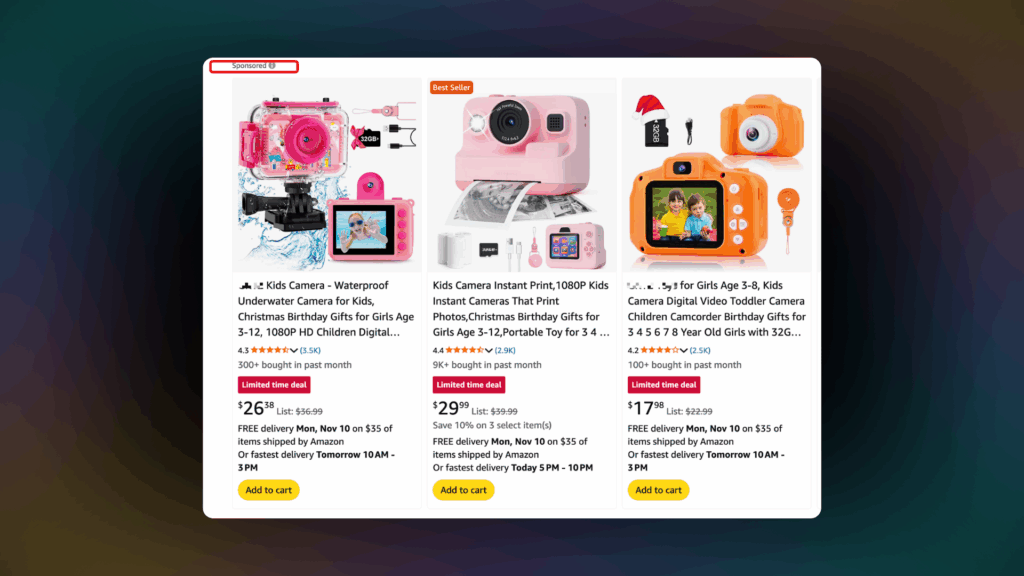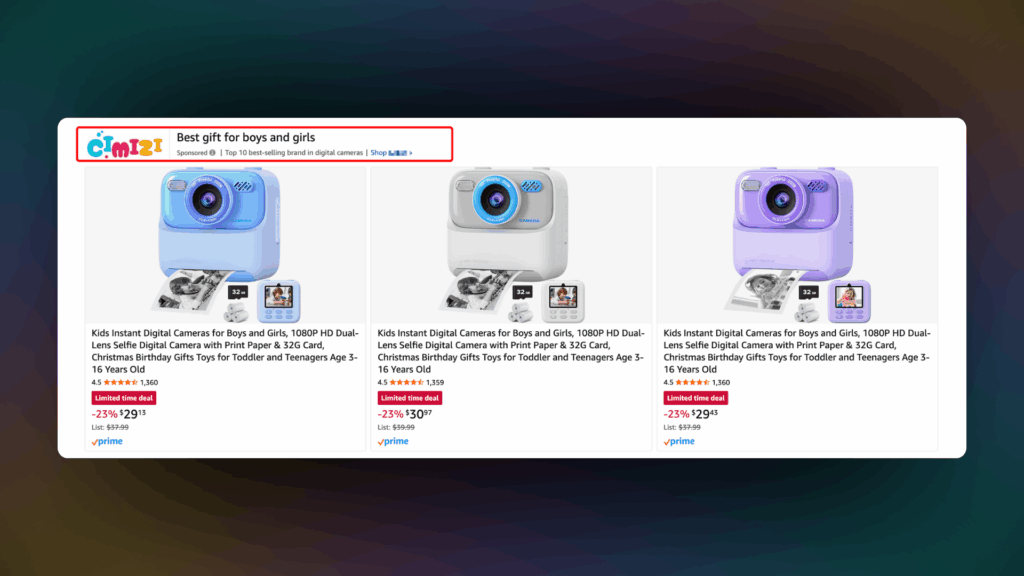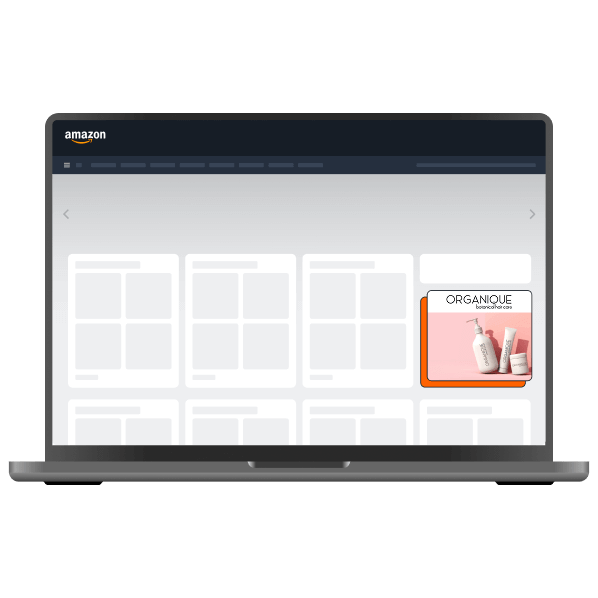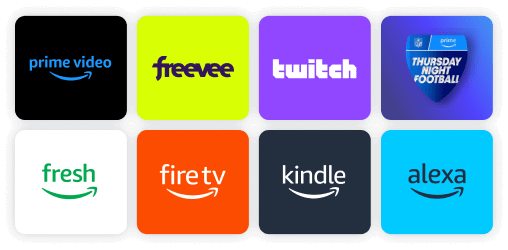- Blog
-
For Sellers
The ultimate Amazon PPC advertising guide for beginners
A clear, beginner-friendly breakdown of what makes Amazon PPC campaigns succeed.

New Amazon sellers often lose money on their first PPC campaigns, and it’s usually because they’re advertising products that shouldn’t be advertised in the first place. Throwing ad dollars at unprofitable products is like trying to polish a stone into a diamond. Expensive and futile.
Most PPC guides jump straight into campaign setup, keyword research, and bidding strategies. They assume you already have profitable products, optimized listings, and solid inventory management.
This guide takes a different approach. We’ll cover the business foundations that make PPC profitable, then walk through the tactical steps to launch your first successful campaign.
What is Amazon PPC advertising?
Amazon PPC is the marketplace’s internal auction system where sellers bid on keywords to get their products in front of shoppers. You only pay when someone clicks your ad, not when it appears on the screen. Think of it as renting prime real estate in Amazon’s search results. The better your bid and ad quality, the better your spot.
The system works through auctions where sellers set maximum bids for keywords or product targets. Amazon’s algorithm decides which ads appear based on your bid amount and how well your ad performs (click-through rates, conversion history, and listing quality). Your ads can show up in search results, on product detail pages, or even on external websites through Amazon’s advertising network.
Here’s what makes Amazon different from Google or Facebook advertising: shoppers on Amazon are already looking to buy something. They’re not browsing for entertainment. They’re searching with their wallets ready. This means Amazon PPC typically converts at much higher rates than other advertising platforms.
The key metrics you’ll encounter are:
- CPC (Cost-Per-Click): What you pay each time someone clicks your ad
- ACoS (Advertising Cost of Sales): Your ad spend divided by attributed sales
- RoAS (Return on Ad Spend): How much sales revenue you generate per advertising dollar
- Impressions, CTR, Conversion Rate: Indicators of how visible and effective your ads are
Amazon offers both automatic campaigns (where Amazon picks your keywords) and manual campaigns (where you choose exactly what to target). Most beginners should start with automatic campaigns to learn what actually works before diving into manual keyword selection.
Organic ranking isn’t enough anymore
Now, before we begin, this is something you need to understand. Amazon now hosts hundreds of millions of active products, making organic visibility increasingly difficult to achieve.
The competition for those coveted first-page spots has intensified dramatically since 2020. Even if you have a great product with solid reviews, getting discovered without paid advertising has become nearly impossible for new listings.
Amazon’s search algorithm rewards products that demonstrate consistent sales velocity and conversion rates. But here’s the problem: you need traffic to generate sales, and you need sales to improve your organic ranking. It’s a classic catch-22 that PPC helps solve.
Successful Amazon sellers in 2025 use a hybrid approach. They optimize for organic ranking while using PPC to fuel the initial momentum. Even established products benefit from continuous ad traffic to maintain their organic positions and defend against competitors.
The 4 Amazon ad types you should understand first
1. Sponsored Products (Most sellers start here)

Sponsored Products are the bread and butter of Amazon advertising. These ads look almost identical to organic search results, except for a small “Sponsored” label that most shoppers barely notice. They appear in search results and on product detail pages, making them the most natural way to get in front of potential customers.
This ad type operates on a straightforward cost-per-click model where you bid on specific keywords or competitor products.
Amazon offers two targeting methods: automatic targeting (where Amazon’s algorithm selects relevant keywords) and manual targeting (where you choose exactly what to target).
Why start here:
- Easiest to set up and understand
- Directly tied to purchase intent
- Usually delivers the highest return on ad spend
- Perfect for testing which keywords actually convert
The beauty of Sponsored Products lies in their simplicity. You’re essentially paying to skip the line in Amazon’s search results, putting your product in front of shoppers who are already searching for what you sell.
2. Sponsored Brands (When you have Brand Registry and multiple products)

Sponsored Brands are the billboards of Amazon advertising. These ads feature your logo, a custom headline, and multiple products, appearing at the top of search results or as video ads in the middle of the page.
But there’s a catch. You need to be enrolled in Amazon’s Brand Registry program to access this ad type.
These campaigns work best when you have multiple related products to showcase or want to drive traffic to your Amazon Store. You can create product collection ads (showing 2-3 products with a custom tagline), store spotlight ads (directing traffic to your storefront), or 15-30 second video ads that autoplay in search results.
Sponsored Brands typically generate higher brand awareness than Sponsored Products, but often have lower immediate conversion rates. They’re particularly effective for established sellers looking to cross-sell products or build brand recognition among their target audience.
3. Sponsored Display (For retargeting and broader reach)

Sponsored Display ads work like digital stalkers… in the best possible way. These ads target shoppers who viewed your product but didn’t buy, following them around Amazon and even to external websites like Google, Facebook, Netflix, and mobile apps. If someone looked at your product page yesterday, they might see your ad on their favorite news site today.
This ad type supports both static images and video formats, appearing under the Buy Box on product pages or as banner ads on external sites. You can target specific competitor products (appearing on their detail pages), interest-based audiences, or shoppers who viewed similar items.
Best used for:
- Retargeting visitors who didn’t purchase
- Expanding awareness beyond Amazon’s search results
- Competitive targeting of rival products
- Reaching new audiences based on shopping behavior
Sponsored Display ads typically have lower conversion rates than Sponsored Products, but offer massive reach. They’re most effective after you’ve established profitable Sponsored Products campaigns and want to expand your advertising footprint.
4. Amazon DSP (Advanced option for larger budgets)

Amazon DSP (Demand-Side Platform) is the enterprise-level advertising option that most beginners should ignore until they’ve mastered the basics. This programmatic advertising network allows you to buy display, audio, and video placements across Amazon and thousands of third-party websites.
DSP campaigns target audiences based on sophisticated behavioral data, purchase intent signals, and demographic information. You can reach people who bought similar products, visited specific categories, or match your existing customer profiles.
The catch? DSP typically requires a minimum monthly spend of thousands of dollars and is often managed through certified partners.
How much Amazon PPC actually costs
Amazon PPC costs vary wildly depending on your category, competition level, and how aggressively you bid.
In low-competition niches, you might pay $0.40-$0.80 per click. For moderate competition categories like home goods, kitchen items, or beauty products, expect $0.80-$1.50 per click. High-stakes categories like electronics, supplements, and popular consumer goods can push costs to $1.50-$3.00+ per click.
Premium placements and highly competitive keywords can drive costs above $5 per click. These numbers fluctuate based on seasonality, market trends, and how many other sellers are fighting for the same keywords. Black Friday costs more than a random Tuesday in February.
The key insight here is that CPC alone doesn’t determine profitability. A $3 click that converts 20% of the time might be more profitable than a $0.50 click with a 2% conversion rate.
Daily budget recommendations for beginners
Amazon and advertising experts consistently recommend starting with at least $10 per day per campaign, though $50 daily often produces more meaningful results. Lower budgets can cause your ads to stop running early in the day, limiting your data collection and visibility windows.
Your budget needs to support at least 20-30 clicks per day to gather actionable performance data within two weeks. In high-CPC categories, this math quickly pushes your minimum viable budget toward the higher end of the range.
Budget management tip: Amazon allows unused daily budget to roll over within the same month, so conservative daily budgets won’t necessarily limit your total monthly spend if performance justifies scaling.
The hidden costs
The sticker price of clicks tells only part of the PPC story. Managing successful campaigns requires consistent optimization—testing keywords, adjusting bids, adding negative targets, and refining creative assets. Plan on spending 2-10 hours per week managing campaigns, depending on your catalog size and advertising complexity.
Learning to interpret campaign reports, identify profitable keywords, and understand when to make adjustments takes months to master. Many sellers underestimate this opportunity cost, either overspending on poor-performing keywords or missing chances to scale profitable ones.
The most expensive PPC mistake isn’t high CPCs. It’s running unoptimized campaigns that drain budget without generating insights or sales. Treat your first few months as paid education rather than immediate profit generation.
Break-even basics
Your break-even ACoS equals your profit margin multiplied by 100. If your product has a 30% profit margin, your break-even ACoS is 30%. When your ACoS stays below your profit margin, campaigns generate profit. When ACoS exceeds your profit margin, you’re investing in visibility and ranking rather than immediate returns.
Some product categories tolerate higher ACoS because of repeat purchases, subscription potential, or cross-selling opportunities. Consumable products like supplements or pet food often justify higher advertising costs since customer lifetime value compensates for initial acquisition expenses.
Important metric: Track TACoS (Total Advertising Cost of Sales) alongside ACoS. TACoS measures your ad spend against total sales (organic plus paid), showing how advertising affects your overall business profitability rather than just campaign performance. The formula is: (Total Ad Spend / Total Sales) x 100.
Your first Amazon PPC campaign setup
Before you begin…
Start with profitable products only.
Launching PPC campaigns for low-margin products almost guarantees wasted spending. Before turning on ads, confirm your profit margins can sustain paid traffic while covering Amazon fees, cost of goods sold, and your advertising investment. Aim for at least 30-40% gross profit margins before advertising to ensure campaigns can break even at typical ACoS levels of 20-35%.
Categories like supplements, consumables, or products with subscription potential can tolerate higher ACoS because repeat purchases offset initial acquisition costs. But for most products, healthy margins are non-negotiable for sustainable PPC success.
Remember: advertising amplifies your current business performance. If a product isn’t profitable through organic sales, ads will only amplify those losses.
Optimize listings before spending ad dollars.
PPC drives traffic, but only optimized product listings convert that traffic into sales. Your product title, images, bullet points, A+ Content, and reviews must already perform well organically before investing in paid visibility. Ads cannot fix poor conversion rates. They only make expensive conversion problems more expensive.
Test your listing’s organic performance first. If your product doesn’t convert after receiving 100+ visits naturally, refine your listing or pricing before launching campaigns. High-quality images, keyword-rich copy, competitive pricing, and at least 15-20 reviews form the foundation of successful advertising.
Inventory management that supports advertising success.
PPC can trigger sudden sales velocity spikes, directly impacting your organic search ranking. Running out of stock mid-campaign wastes your advertising budget and resets the ranking momentum you’ve paid to build. Amazon’s algorithm penalizes inconsistent availability, making future advertising efforts more expensive and less effective.
Ensure you have at least 60 days of inventory at projected sales velocity before launching campaigns. Avoid advertising low-stock SKUs unless you’re deliberately liquidating inventory. Successful PPC requires operational stability to maximize your advertising investment.
PPC campaign structure for beginners
Start with one automatic Sponsored Products campaign.
Your first campaign should target a single product through Amazon’s automatic targeting system. This approach lets Amazon’s algorithm choose relevant keywords based on your product listing and customer search behavior, serving as real-world keyword research that identifies what shoppers actually search when looking for your product.
Automatic campaigns require minimal setup while providing maximum learning opportunities. Run your first campaign for at least 14 days to gather meaningful data on impressions, clicks, and conversions before making any major adjustments.
Simplicity beats complexity.
Many new sellers overcomplicate their PPC setup with multiple campaigns, match types, and ad groups before understanding the basics. Your first campaign’s goal should be data collection and learning, not maximizing immediate scale.
Fewer moving parts mean you can clearly see cause and effect: which keywords convert, what your CPC trends look like, and how ACoS behaves over time.
Once you’ve gathered solid performance data, you can graduate to manual campaigns using the strongest-performing keywords from your automatic campaign. Think of automatic campaigns as training wheels that help you understand Amazon’s advertising environment with minimal risk and complexity.
Budget and bidding for your first campaign
Set realistic daily budgets.
Amazon recommends at least $10-50 per day for beginners, but the right budget depends on your category’s CPC levels and conversion goals. Your daily budget should support 20-30 clicks to generate meaningful performance data within two weeks. Lower budgets may prevent your ads from running long enough each day to reach statistical significance.
Start conservatively but ensure your budget covers sufficient traffic volume. Amazon may reallocate unused daily budget to busier days within the same month, so conservative daily limits won’t necessarily restrict your total monthly investment if performance justifies scaling.
Use Amazon’s suggested bids as starting points.
Each keyword or product target displays a suggested bid range based on competitive auction data. Start with bids at or slightly above the midpoint of Amazon’s range—typically $0.75-$1.50 for most categories. If you consistently receive low impressions despite adequate budgets, gradually increase bids by $0.10-$0.20 until you achieve consistent visibility.
Avoid setting extreme bids early in your learning process. Overly high CPCs can drain budgets before you collect reliable performance data, while bids that are too low may prevent your ads from entering auctions entirely.
Choose automatic bidding for your first campaigns.
Automatic bidding lets Amazon manage keyword selection and bid adjustments dynamically, reducing the complexity of your first campaigns. Manual bidding becomes valuable later, once you’ve identified high-performing keywords and want precise control over targeting and costs.
Consider using dynamic bidding with the “up and down” setting initially, which allows Amazon to increase bids when conversion likelihood is high and decrease them when prospects look poor. Switch to “down only” dynamic bidding once your campaign data stabilizes and you want more predictable spending patterns.
How to read and optimize your campaign performance
Focus on metrics that matter.
ACoS (Advertising Cost of Sales) measures your ad spend divided by attributed sales, serving as your primary profitability indicator.
Clicks show engagement levels—low clicks may signal weak product images, titles, or targeting relevance.
Conversions reveal product-market fit and listing quality, with 10-15% conversion rates typical for successful Sponsored Products campaigns.
Secondary metrics include CTR (Click-Through Rate), which helps assess ad relevance and image appeal, and RoAS (Return on Ad Spend), showing total return per advertising dollar invested. Don’t obsess over impressions alone—prioritize clicks and conversions for actionable insights about campaign effectiveness.
These metrics work together to tell your campaign’s complete story. High impressions with low clicks suggest targeting or creative issues. High clicks with low conversions point to listing optimization opportunities rather than advertising problems.
Allow a week or two before adjustments.
Let campaigns run for at least 7-14 days before making significant changes. Amazon’s attribution window and data processing delays mean early statistics don’t reflect full performance potential. The platform needs time to optimize your ad delivery based on actual shopper behavior and conversion patterns.
After a week or two, evaluate key questions: Are you spending too quickly relative to sales? Is your ACoS above your profit margin? Which specific keywords or targets generate conversions? Consistent underperformance after this initial period signals it’s time for optimization rather than patience.
Resist the urge to make daily adjustments based on short-term fluctuations. Amazon’s learning algorithms work best with stable campaign parameters, and frequent changes can reset optimization progress.
Simple optimization tactics that work:
Add negative keywords to prevent ads from showing for irrelevant searches like wrong product variants, competing brands, or unrelated terms. Review your search term reports weekly to identify wasteful spending on irrelevant clicks.
Adjust bids strategically: Lower bids for keywords that generate clicks without conversions, and increase bids on terms that convert profitably. Pause poor performers after they’ve received more than 10 clicks without generating sales—they’re unlikely to improve with additional investment.
Move winning keywords from automatic to manual campaigns for tighter control over bids and budgets. This graduation system lets you scale profitable terms while continuing to discover new opportunities through automatic targeting.
Recognize success signals and warning signs.
Campaign health indicators include stable or improving ACoS, steady sales growth, high CTR above 0.3-0.5%, and consistent conversion rates. Successful campaigns typically show gradual improvement over 4-6 weeks as Amazon’s algorithms optimize delivery.
Warning signals include rapid budget consumption with few sales, extremely high ACoS above 50%, or stagnant impression levels despite competitive bids. If campaigns overspend without converting, reassess your listing quality, keyword relevance, and price competitiveness before increasing advertising investment.
Remember that campaign performance often fluctuates during the first month as Amazon collects data and optimizes ad delivery. Focus on weekly and monthly trends rather than daily variations when evaluating success.
Common beginner mistakes that waste advertising budget
Advertising fundamentally flawed products.
We’ve said it before, and we’d say it again. PPC cannot transform unprofitable or unappealing products into winners.
Ads amplify your listing’s current performance. If your product doesn’t convert organic traffic well, advertising will only magnify those conversion problems at a higher cost.
Test organic performance first: products that don’t convert after 100+ natural visits need listing improvements before advertising investment makes sense.
Poor product-market fit, weak value propositions, or pricing issues won’t magically resolve through increased visibility. Fix the fundamentals before spending money to drive more traffic to a broken experience.
Expecting immediate profits from new campaigns.
PPC functions as a data-gathering and ranking strategy first, not a guaranteed instant profit machine. New products often experience high ACoS during the first few weeks while Amazon’s algorithms collect performance data and improve ad relevance.
This initial investment period typically lasts 2-4 weeks before campaigns stabilize into predictable performance patterns.
Sellers who expect overnight profitability often pause campaigns too early, missing opportunities to build organic ranking momentum that pays dividends long-term. Treat your first month as paid market research rather than immediate revenue generation.
Making changes without sufficient data.
Reacting to early performance fluctuations destroys more campaigns than poor keyword selection. Amazon’s attribution system can lag 48-72 hours, making immediate campaign changes based on preliminary data counterproductive. Frequent adjustments reset Amazon’s learning algorithms, causing inconsistent ad delivery and wasted budget.
Neglecting business foundations while chasing advertising tactics.
PPC success depends on operational excellence in areas like inventory management, customer service, and product quality. Advertising cannot compensate for stockouts, poor reviews, or unreliable fulfillment. These operational issues make advertising more expensive and less effective over time.
Treat PPC as one component of a complete business system rather than a standalone profit solution. Strong fundamentals in sourcing, pricing, inventory, and customer experience create the foundation that makes advertising investment worthwhile and sustainable.
Your next steps
Successful advertising requires profitable products, optimized listings, reliable inventory management, and accurate cost tracking long before you start bidding on keywords. The sellers who win at PPC aren’t necessarily the ones with the biggest advertising budgets. They’re the ones with the strongest operational foundations.
Think of advertising as rocket fuel for an already well-built machine. You need efficient sourcing to find profitable products worth advertising, streamlined inventory management to handle increased sales velocity, and accurate profit tracking to understand which campaigns actually make money. Without these systems in place, even successful campaigns can mask underlying profitability problems.
While mastering PPC takes time, having the right business foundation makes advertising success inevitable. The most successful Amazon sellers combine smart advertising with comprehensive operational tools that handle everything from product sourcing to profit tracking.
Discover how Seller 365’s complete toolkit helps thousands of sellers build the profitable operations that make advertising investment worthwhile—with all the essential tools in one affordable subscription.






















